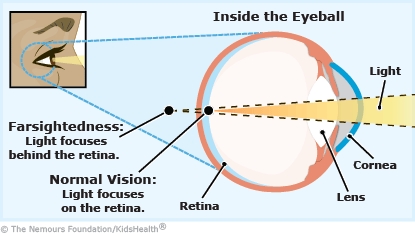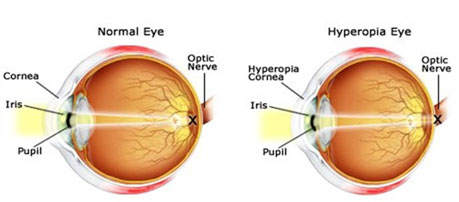
Farsightedness is a condition in which light rays entering the eye are focused on the retina instead of directly on the pupil. People who are farsighted have eyeballs that are shorter than normal. This condition affects many children, but some will outgrow it with normal growth. Adults who have farsightedness may need contact lenses or glasses to correct their vision. They should wear these glasses or contact lenses whenever doing close-up work, such as reading a book or working on computers.
When the lens of the eye becomes thicker and more rigid, it cannot accommodate close-up vision. As a result, people with farsightedness may have trouble seeing details of objects. The main symptom of farsightedness is difficulty focusing on close objects, as well as headaches and eyestrain. If you are concerned about your eyesight, consult your eye doctor as soon as you begin experiencing these symptoms. There is no treatment for presbyopia, but a specialist can help you get your eyesight back to normal.
A basic eye exam can be used to diagnose farsightedness and hyperopia. A doctor will use a phoropter or retinoscope to measure the reflection of light off the retina. This will help determine which prescriptions are best suited for the type of farsightedness you have. For adults who do not suffer from any vision problems, they should visit an eye doctor every two to four years. Those who have no symptoms should schedule an eye examination at least once a year.
Farsightedness is often associated with poor reading performance. It may also lead to a lack of interest in reading. In fact, many older individuals with farsightedness have trouble reading. In adults, it does not affect their ability to drive. An eye doctor can detect farsightedness by using a sight chart, which shows rows of smaller letters. In some cases, the chart may be unable to detect farsightedness. If this is the case, a patient must undergo a refractive surgery to correct their vision.

In adults with far -sighted, the center of eye lenses cannot adapt to myopia. The center of the lens is a complex part of the eyes, which is not flexible enough to adapt the vision of people with myopia. In this case, contact lenses and glasses should be worn to fix the problem. It is important to note that an increase in foresight occurs at almost all aged thirty to forty.
In adults, the lens of the eyes is too hard and thick, which leads to blurry vision. People with far -sightedness often experience headaches and eyes. In addition to this, foresight can lead to myopia or myopia. For this reason, it is important to undergo an annual eye examination in order to ensure clear vision. Even if you had previous problems with vision, you may have a long -sighted state.
With age, our eyes become more and more sensitive to the light. Those who have a ranger usually have blurry vision, which leads to headaches and a load on the eyes. If you are a child, it is better to inspect the eyes every two years. You must also take into account any changes in your eyes that can be associated with your vision. If you have a story of short -sighted ones, you can suffer from foresight.
A farsighted eye will not properly refract light, and therefore will have blurred vision. This is a common condition, which affects about half of the population. It can also affect your eyesight. Almost everyone will experience increasing farsightedness as they get older, and the condition will likely worsen with age. If you’re in your forties, you may have mild cases of the condition. If you have nearsightedness, your eyesight will probably only get worse with time.
The condition is a serious one. It can cause headaches and difficulty seeing close-up details. Symptoms of farsightedness include headaches and eyestrain, and difficulty with reading. If you don’t have symptoms, you should seek out an eye doctor and get a complete eye examination. You might be suffering from farsightedness. Don’t let this happen to you! There are solutions for your vision problem. You can improve your vision with eyeglasses and contact lenses.